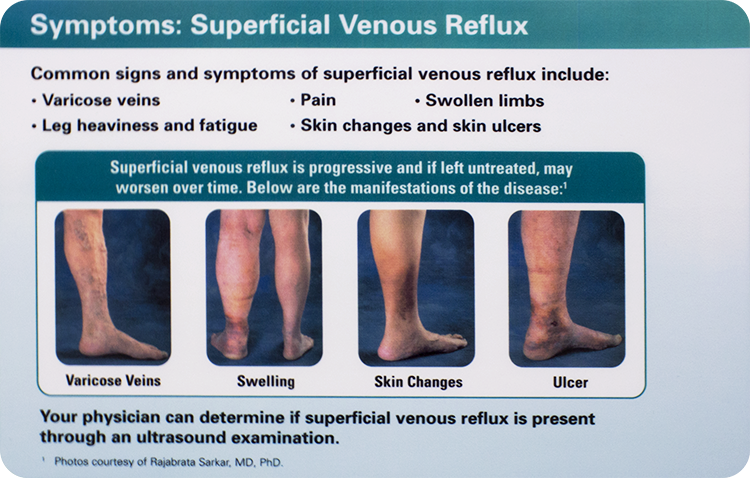Varicose Veins
What are Varicose Veins?
Varicose veins are unsightly bulges seen usually through the skin on the legs affecting both men and women. These bulges are seen as a cosmetic problem, but there may be deeper medical issues as well. Varicose veins are the result of diseased veins with weakened walls and valves. These weaknesses in the veins may be congenital or may occur as a result of precipitating events or lifestyle habits. Many have found this condition to be painful.
Although this condition affects both men and women, only about a quarter of patients suffering are men. Women tend to seek help for the disorder as they expose their legs more frequently than men. Regardless of gender, varicose veins should still be seen by a doctor as they can require medical intervention.


How do varicose veins Develop?
Who Is At Risk For Developing Varicose Veins?
There are a number of risk factors that could result in the development of varicose veins. Varicose Veins may appear in obese individuals, pregnant women, or individuals with a family history of varicose veins. If an individual works in a profession that requires a great deal of either sitting or standing, or spends a large amount of time traveling in cars or airplanes, they are at a higher risk. Smoking also increases the chances of developing venous insufficiency.
Causes of Varicose Veins
Causes of Venous Insufficiency and Varicose Veins include the following:
- Heredity
- Gender
- Pregnancy
- Age
- Prolonged sitting or standing
- Hormone levels
- Physical Trauma
How Are Varicose Veins Diagnosed?
Most of the time Varicose Veins will be evident from skin swelling or discoloration. To truly diagnose the severity of the condition, an ultrasound and angioplasty may be required.
Symptoms of Varicose Veins and Venous Insufficiency
Common Symptoms:
- Aching
- Night cramps
- Heaviness
- Tiredness
- Burning
- Numbness
- Tingling
- Swelling
- Throbbing
- Tender areas around veins
- Pain
- Itching
- Skin color changes
- Unsightly varicose and spider veins
- Restless leg syndrome

Advanced Symptoms:
- Ankle Sores
- Skin Ulcers
- Bleeding
- Inflammation
- Blood Clots
Can Varicose Veins Be Prevented?
Varicose veins are unsightly and can cause significant discomfort in your lower extremities. While preventing varicose veins is difficult, you can make simple everyday changes to help relieve the discomfort from existing varicose veins. These changes include:
- Exercising regularly
- Avoid prolonged sitting or standing
- Maintain a healthy weight
- Avoid taking high-estrogen pills (i.e. birth control pills)
- Wear compression stockings
- Relax and elevate your legs
- Avoid wearing clothing or shoes that limit the use of calf muscles and restrict blood flow (i.e. high heels)
Although helpful, these suggestions do not treat the underlying cause of venous disease.
Treatment of Varicose Veins
Depending on the severity of your individual case, there are many treatment options available for the treatment of varicose veins. These treatment possibilities may include:
Home Treatment
When varicose veins are mild, at home treatment by the patient can successfully treat varicose veins. This includes plenty of exercise, avoiding long periods of sitting or standing, and elevating the legs when at rest.
Sclerotherapy
During sclerotherapy treatment, a liquid called a sclerosant is injected into the affected vein to cause it to close and stop carrying blood. Treatment will take an hour or less and does not require anesthetic. Patients will experience little to no discomfort.
Foam Sclerotherapy
Foam sclerotherapy for varicose veins is a treatment option used to eliminate intermediate-sized veins that are too large to be treated with regular sclerotherapy and veins that cannot be treated with Endovenous Laser Ablation (EVLT).
Endovenous Laser Treatment (EVLT)
EVLT uses a small amount of local anesthesia (Lidocaine) a laser fiber is inserted into the problem vein usually just above the knee through a very small needle. The laser will activate and seal the vein.
Microphlebectomy
Microphlebectomy for varicose veins is a procedure done to remove large & visible surface varicose veins. The treatment targets veins that are too large or tortuous for Endovenous Laser Ablation (EVLT) or sclerotherapy treatments.
What Are The Dangers of Varicose Veins?
In patients of either gender, the biggest risk of having varicose veins is that the patient may develop a clot, or deep vein thrombosis (DVT), that may travel to another part of the body. This is referred to as an embolism and is a life-threatening condition. If the clot dislodges of the walls of the vein and travels to the lungs, it is called a pulmonary embolism. If the clot travels to the brain, it may result in a possible stroke. A clot that travels to the heart may cause a heart attack.
A clot may occur in a milder form called phlebitis or superficial thrombophlebitis. While this is less serious than DVT, phlebitis must be medically treated to assure that the condition doesn’t worsen.
Will Treatment Affect My Circulation?
After receiving treatment for the affected veins, the blood flow will naturally redirect to your healthy veins allowing circulation to continue uninterrupted.
